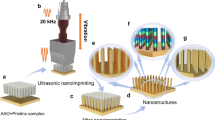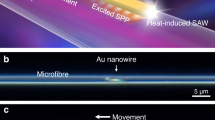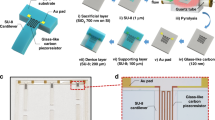Abstract
Although actuation in biological systems is exclusively powered by chemical energy, this concept has not been realized in man-made actuator technologies, as these rely on generating heat or electricity first1. Here, we demonstrate that surface-chemistry-driven actuation can be realized in high-surface-area materials such as nanoporous gold. For example, we achieve reversible strain amplitudes of the order of a few tenths of a per cent by alternating exposure of nanoporous Au to ozone and carbon monoxide. The effect can be explained by adsorbate-induced changes of the surface stress2, and can be used to convert chemical energy directly into a mechanical response, thus opening the door to surface-chemistry-driven actuator and sensor technologies.
This is a preview of subscription content, access via your institution
Access options
Subscribe to this journal
Receive 12 print issues and online access
$259.00 per year
only $21.58 per issue
Buy this article
- Purchase on Springer Link
- Instant access to full article PDF
Prices may be subject to local taxes which are calculated during checkout



Similar content being viewed by others
References
Ebron, V. H. et al. Fuel-powered artificial muscles. Science 311, 1580–1583 (2006).
Ibach, H. The role of surface stress in reconstruction, epitaxial growth and stabilization of mesoscopic structures. Surf. Sci. Rep. 29, 193–263 (1997).
Baughman, R. H. Playing nature’s game with artificial muscles. Science 308, 63–65 (2005).
Weissmüller, J. et al. Charge-induced reversible strain in a metal. Science 300, 312–315 (2003).
Mirfakhrai, T., Madden, J. D. W. & Baughman, R. H. Polymer artificial muscles. Mater. Today 10, 30–38 (2007).
Kramer, D., Viswanath, R. N. & Weissmüller, J. Surface-stress induced macroscopic bending of nanoporous gold cantilevers. Nano Lett. 4, 793–796 (2004).
Viswanath, R. N., Kramer, D. & Weissmüller, J. Adsorbate effects on the surface stress-charge response of platinum electrodes. Electrochim. Acta 53, 2757–2767 (2008).
Haiss, W. Surface stress of clean and adsorbate-covered solids. Rep. Prog. Phys. 64, 591–648 (2001).
Feibelman, P. J. First-principles calculations of stress induced by gas adsorption on Pt(111). Phys. Rev. B 56, 2175–2182 (1997).
Kim, J., Samano, E. & Koel, B. E. Oxygen adsorption and oxidation reactions on Au(211) surfaces: Exposures using O2 at high pressures and ozone (O3) in UHV. Surf. Sci. 600, 4622–4632 (2006).
Zielasek, V. et al. Gold catalysts: Nanoporous gold foams. Angew. Chem. Int. Ed. 45, 8241–8244 (2006).
Biener, M. M., Biener, J. & Friend, C. M. Enhanced transient reactivity of an O-sputtered Au(111) surface. Surf. Sci. 590, L259–L265 (2005).
Erlebacher, J. et al. Evolution of nanoporosity in dealloying. Nature 410, 450–453 (2001).
Biener, J. et al. Size effects on the mechanical behavior of nanoporous Au. Nano Lett. 6, 2379–2382 (2006).
van Bokhoven, J. A. et al. Activation of oxygen on gold/alumina catalysts: In situ high-energy-resolution fluorescence and time-resolved X-ray spectroscopy. Angew. Chem. Int. Ed. 45, 4651–4654 (2006).
Newman, R. C. et al. Alloy corrosion. MRS Bull. 24, 24–28 (1999).
Cattarin, S., Kramer, D., Lui, A. & Musiani, M. M. Preparation and characterization of gold nanostructures of controlled dimension by electrochemical techniques. J. Phys. Chem. C 111, 12643–12649 (2007).
Yim, W. L. et al. Universal phenomena of CO adsorption on gold surfaces with low-coordinated sites. J. Phys. Chem. C 111, 445–451 (2007).
Hodge, A. M. et al. Scaling equation for yield strength of nanoporous open-cell foams. Acta Mater. 55, 1343–1349 (2007).
Weissmüller, J. & Cahn, J. W. Mean stresses in microstructures due to interface stresses: A generalization of a capillary equation for solids. Acta Mater. 45, 1899–1906 (1997).
Viswanath, R. N., Kramer, D. & Weissmüller, J. Variation of the surface stress-charge coefficient of platinum with electrolyte concentration. Langmuir 21, 4604–4609 (2005).
Zepeda-Ruiz, L. A. et al. Mechanical response of freestanding Au nanopillars under compression. Appl. Phys. Lett. 91, 101907 (2007).
Diao, J. K., Gall, K. & Dunn, M. L. Atomistic simulation of the structure and elastic properties of gold nanowires. J. Mech. Phys. Solids 52, 1935–1962 (2004).
Fiorentini, V., Methfessel, M. & Scheffler, M. Reconstruction mechanism of fcc transition-metal (001) surfaces. Phys. Rev. Lett. 71, 1051–1054 (1993).
Torres, D., Neyman, K. M. & Illas, F. Oxygen atoms on the (111) surface of coinage metals: On the chemical state of the adsorbate. Chem. Phys. Lett. 429, 86–90 (2006).
Umeno, Y. et al. Ab initio study of surface stress response to charging. EPL 78, 13001 (2007).
Min, B. K. et al. Efficient CO oxidation at low temperature on Au(111). J. Phys. Chem. B 110, 19833–19838 (2006).
Acknowledgements
Part of this work was carried out under the auspices of the US Department of Energy by Lawrence Livermore National Laboratory under Contract DE-AC52-07NA27344. The authors want to express special thanks to F. F. Abraham (LLNL) and M. Duchaineau (LLNL) for generating the nanoporous Au samples for the molecular dynamics simulations.
Author information
Authors and Affiliations
Corresponding author
Rights and permissions
About this article
Cite this article
Biener, J., Wittstock, A., Zepeda-Ruiz, L. et al. Surface-chemistry-driven actuation in nanoporous gold. Nature Mater 8, 47–51 (2009). https://doi.org/10.1038/nmat2335
Received:
Accepted:
Published:
Issue Date:
DOI: https://doi.org/10.1038/nmat2335
This article is cited by
-
Uniaxial Compression Behavior of Open Cellular Materials with Spinodal Morphologies Fabricated by Additive Manufacturing
Transactions of the Indian Institute of Metals (2023)
-
Atomistic simulation of the effect of porosity on shock response of nanoporous gold
Journal of Molecular Modeling (2023)
-
Synthesis and Microstructure Influenced Antimicrobial Properties of Dispersed Nanoporous Gold Rods
Transactions of the Indian Institute of Metals (2022)
-
Liquid metal assisted regulation of macro-/micro-structures and mechanical properties of nanoporous copper
Science China Technological Sciences (2021)
-
Macro-/micro-coupling regulation of nanoporous metals via vapor phase alloying-dealloying
Science China Materials (2021)



